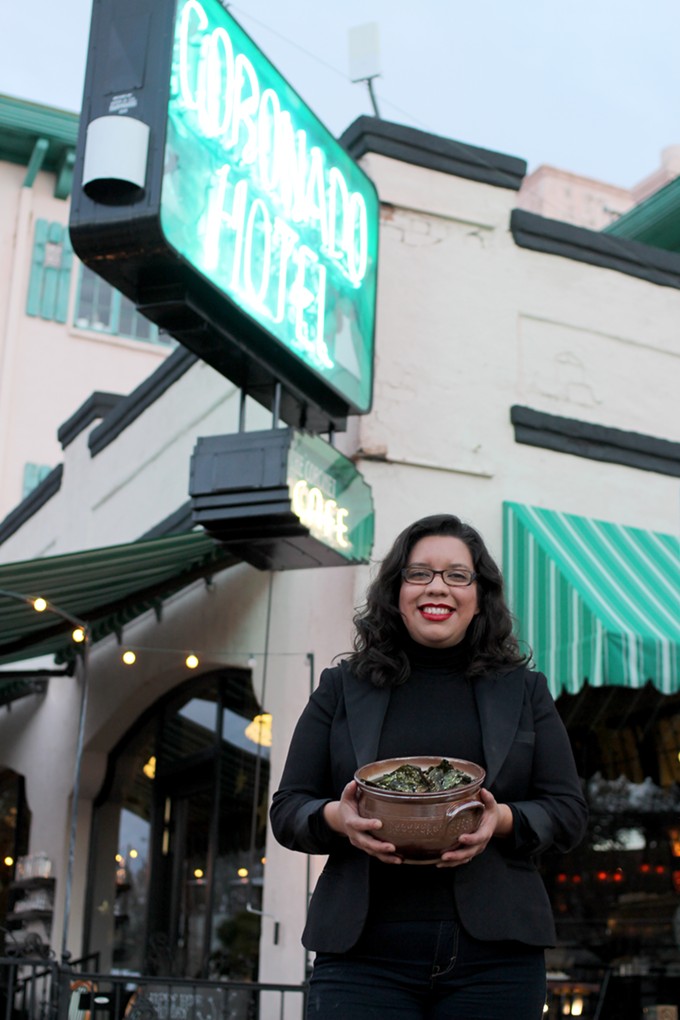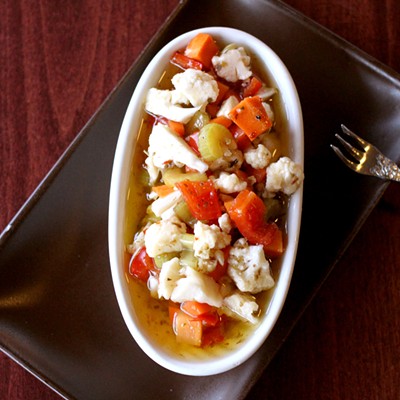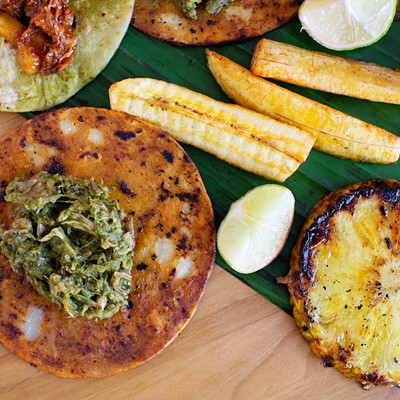We've all been there. You're staring at a menu and trying to do the right thing. The cheese covered pasta and the pork chops are both calling your name, but you're going to be good. You're going to get a salad. Unfortunately, many times it seems salads compositionally take a backseat to entrées. That can mean any number of dissatisfying ends: the salad could be unbalanced in flavor or texture, the veggies themselves could be sourced far out of season and are therefore not super flavorful and, finally and worst of all, a poorly composed salad on one visit could mean you don't get one again.
Chef Erika Bostick knows your pain, and she's here to help. As the chef at The Coronet (402 E. Ninth St.), Bostick has incorporated a cornucopia of fresh, local veggies onto her menu, utilizing each season's special bounty to craft finessed French cuisine. The current menu offers broccolini, mustard greens, rotkohl, kabocha squash, cauliflower, a beet and dill salad and more.
Bostick says her veggie-forward mentality came about rather naturally, in conjunction with The Coronet's owner Sally Kane.
"Sally and I both understood that any well balanced diet has to have veggies—it just has to," she says. "I can't imagine having a meal without some sort of veg."
Perhaps another reason Bostick's menu focused of fresh components is because of the extremely limiting size of The Coronet's kitchen. According to Bostick, the kitchen's only stovetop heat source is an induction burner, and the entire kitchen area is definitely close quarters to say the least.
Now that Kane and Bostick have taken over operations over at Agustin Kitchen (100 Avenida del Convento, #150), Bostick says her new restaurant's massive exposition-style kitchen provides her a much different experience on the line.
"I mean, you've seen it. That huge chef's table is great and the marble prep table is from the gods," she says.
She says creating two very different menus with her two separate teams is actually easier (and "double the fun") since each kitchen's capabilities are so vastly different. However, when she took over Agustin Kitchen's menu, she was met with "a lot of good dishes" that she felt needed minor tweaking. Most prominently, she said each dish got that Bostick veggie touch.
"The dishes have to have more than just a few microgreens on top," she says.
This could mean adding veggies onto an entrée plate, but, one of the most notable changes she's taken on is adding a list of supplemental sides to the menu. That means if you can't stop looking at that pork chop or pasta dish from before, you can also slap on a side of something green and feel a little better about it.
It also means taking veggies out of second chair and into the spotlight. Bostick's connection with local farmers at Maggie's Farm, High Energy Agriculture, Sleeping Frog Farms and South Wind Farms, to name a few, keeps her both in the know and in season.
"We have a personal relationship, so I know what they are growing and what they can grow," she says, adding that she even texts those farmers to discuss the possibilities. From there, it's all a matter of creativity.
When working on a salad, Bostick says the ability to strike the perfect balance, both in flavor and texture, keeps her interested. Crunchy fibrous veggies are a good place to start, which can then be embellished by creamy cheeses, softer roasted vegetables, rich nuts and tart vinaigrette.
"You can hit every note with a salad," she says. "It's a harmony of textures."
She says one of the most common mistakes anyone can make with a salad is overdressing, leaving leaves soggy and the veggies' flavor totally overpowered.
"You want to dress the bowl, not the leaves," Bostick says, explaining that if you pour dressing on the bowl's outer rim, you can incorporate dressing in with more control. She adds, "You can always put in more dressing, but you can never take it away."
When it comes to making dressing, Bostick suggests breaking out the blender and blending fatty roasted nuts, like cashews, macadamias and walnuts, together with a little oil, lemon and roasted garlic. The result is a creamy dressing without any actual dairy.
In fact, Bostick says any starchy veg with soluble fiber, be it cauliflower, squash or potatoes, are a great substitute for a creamy base in soup or sauces. At The Coronet, Bostick makes a creamy baby carrot and cauliflower soup that could fool you into thinking it was full of dairy. Similarly, she says making alfredo sauce with blended cauliflower, rather than cream, is a tasty and tricky way to add vegetables into a less than healthy classic dish.
When it comes to the pasta itself, Bostick recommends playing with spiral veggie slicers or graters and more substantial squashes, like butternut, for a noodle that's as satisfying in texture as it is in taste.
Currently, Bostick is excited to use in season oyster mushrooms, beach mushrooms, winter cabbage, collards (which she says can and should be baked like kale into chips), persimmons, cauliflower, asparagus and kobucha squash. The latter, she says, has a bright green edible rind and an intense orange inside that's a stunning addition visually to any dish. She uses it in the winter kale salad.
Part of mastering any good seasonal bounty, though, is knowing how to preserve excess to use for many meals to come. For one idea on how to do that, Bostick shares her recipe for The Coronet's house giardiniera, which serves up winter veggies with a touch of heat and will likely become your new favorite addition to any plate.













